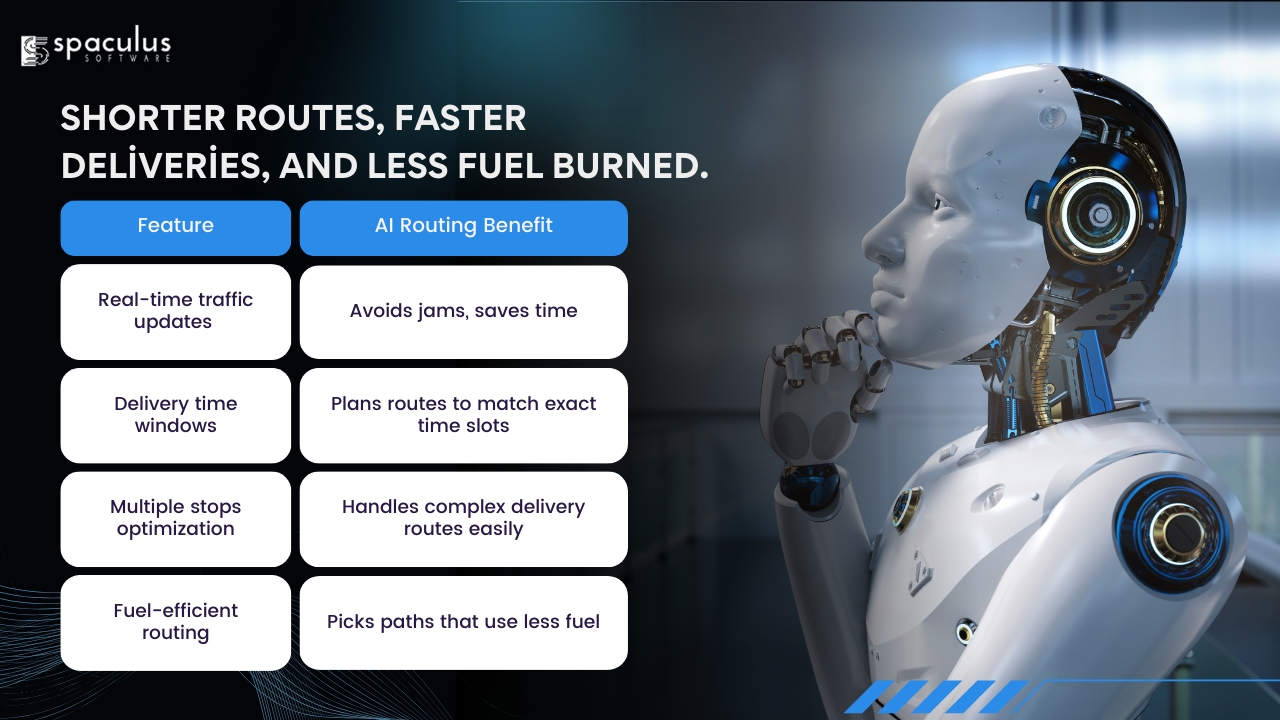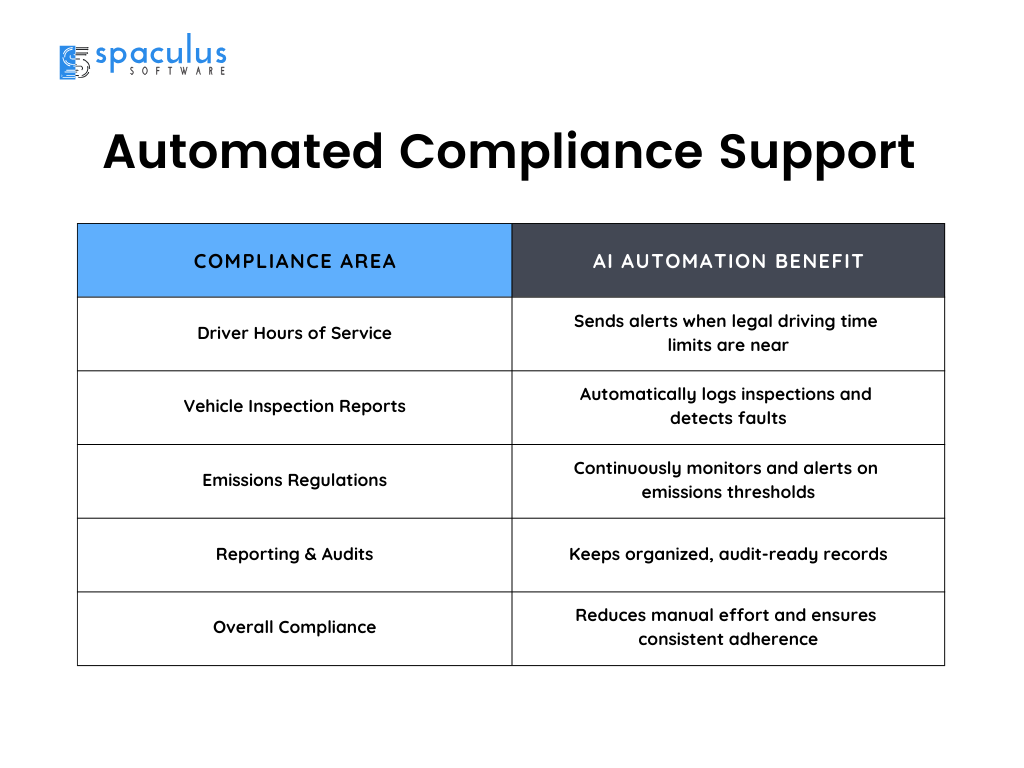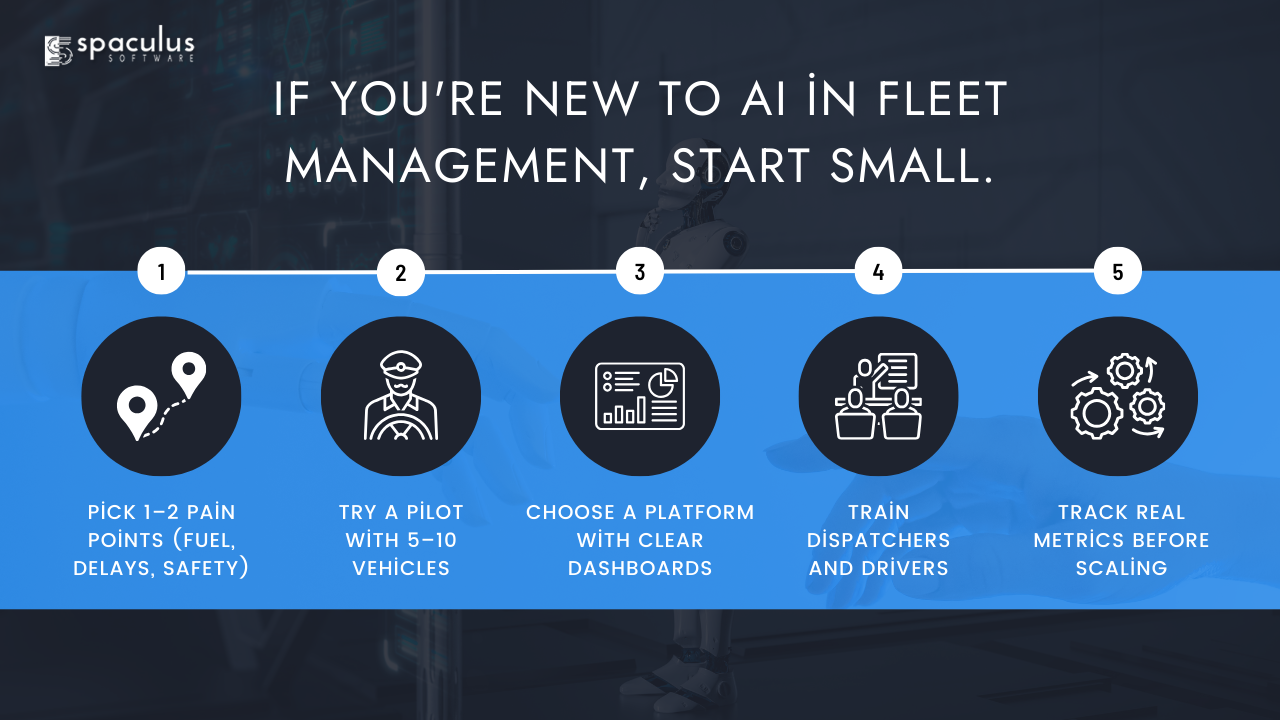
Logistics is changing fast
Fleet management is no longer just about tracking vehicles.
It’s about making smarter decisions, reducing risks, and cutting emissions — all at once.
And today, AI is at the center of this change.
AI in Fleet Management is helping businesses work faster, safer, and cleaner.
From delivery vans to freight trucks, AI is now a must-have for logistics companies that want to stay ahead.
This blog explores how AI is making fleets smarter, roads safer, and logistics greener — without getting too technical.
AI-powered fleet management means using artificial intelligence to run daily operations better.
Instead of relying on spreadsheets or manual updates, AI tools give live insights and smart suggestions.
They help businesses make fast decisions based on data.
This includes:
AI doesn’t replace people.
It helps them do more, with fewer mistakes and less guesswork.
Fleet operations are getting harder.
There are more vehicles on the road, stricter regulations, and growing pressure to reduce carbon footprints.
Customers expect faster delivery, fewer delays, and full visibility.
At the same time, costs for fuel, repairs, and insurance keep rising.
AI helps solve these challenges — not by adding more people, but by working smarter.
One of the biggest advantages of AI is smarter route planning.
Instead of using static maps, AI tools analyze traffic, road closures, weather, and delivery windows — all in real time.
The result: shorter routes, faster deliveries, and less fuel burned.
| Feature | AI Routing Benefit |
| Real-time traffic updates | Avoids jams, saves time |
| Delivery time windows | Plans routes to match exact time slots |
| Multiple stops optimization | Handles complex delivery routes easily |
| Fuel-efficient routing | Picks paths that use less fuel |
These small route improvements can save thousands per month.

AI can also improve road safety.
Using dashcams and sensors, AI systems track how a driver is behaving.
They detect speeding, harsh braking, drowsiness, and phone use.
This data helps coach drivers and prevent accidents before they happen.
| Risk Behavior | AI Detection and Action |
| Speeding | Alerts fleet manager and logs the event |
| Drowsy driving | Detects eye closure, head movement |
| Hard braking/accel | Tracks frequency and compares to norms |
| Phone usage | Camera or telematics detect distractions |
By reducing risky behavior, companies also cut down on insurance claims and vehicle downtime.
Breakdowns cost money.
Not just in repairs, but in missed deliveries, unhappy customers, and wasted driver hours.
AI can spot early warning signs from engine sensors, tire pressure monitors, and brake data.
It tells you when to service a vehicle — before it fails.
| AI Maintenance Feature | Business Impact |
| Real-time engine diagnostics | Find issues before they become breakdowns |
| Predictive repair schedules | Plan service without disrupting operations |
| Sensor-based fault alerts | Avoid major repair bills and delays |
You no longer wait for something to go wrong.
You fix it before it happens.
Fuel is one of the biggest costs in fleet operations.
AI helps reduce this in three ways:
It also tracks CO2 output and gives emissions reports to help meet sustainability goals.
| AI Fuel Optimization | Result |
| Driver behavior scoring | Promotes smoother, fuel-saving driving |
| Idle time alerts | Cuts waste from idling vehicles |
| Emission tracking | Supports carbon reporting and green goals |
This is not just about saving money.
It’s about building a cleaner, more responsible fleet.
With many vehicles and jobs, planning who goes where can be messy.
AI systems optimize dispatch by matching vehicle size, driver availability, and route priority.
They also help balance loads across the fleet — no more half-empty vans or overloaded trucks.
| AI Dispatch Feature | How It Helps |
| Load balancing | Ensures trucks carry full, legal loads |
| Smart driver assignment | Matches jobs based on skills and availability |
| Dynamic rescheduling | Reacts to delays or new orders in real-time |
Smarter planning means fewer empty miles and better use of every vehicle.
From emissions rules to driver hours and rest breaks, fleet operators must follow many regulations.
AI helps automate compliance.
It tracks driving time, checks if vehicles meet emissions limits, and creates clean, ready-to-share reports.
| Compliance Area | AI Automation |
| Driver Hours of Service | Alerts when limits are close |
| Vehicle inspection reports | Auto-records checks and faults |
| Emissions regulations | Monitors and alerts if limits are exceeded |
No more rushing to pull reports during audits.
AI keeps everything clean and on file.

Customers don’t just want deliveries — they want updates.
AI systems provide live tracking links, status updates, and estimated delivery times.
This reduces customer calls, improves trust, and keeps your brand looking sharp.
It also helps internal teams spot problems before clients even notice them.
| Stakeholder | AI Visibility Benefit |
| Dispatch team | Tracks all vehicles live |
| Customers | See accurate arrival windows |
| Managers | Monitor fleet health and delivery KPIs |
Transparency helps everyone work better together.
AI does not just collect data.
It acts on it.
That means if a driver is off-route, or if a tire pressure drops, or if a truck is late — it will tell you.
It can also suggest actions: change the route, switch drivers, or delay the next job.
| Alert Type | AI Response |
| Vehicle off-course | Sends alert and route correction |
| Unexpected delay | Suggests new ETA and notifies customer |
| High-risk driving | Alerts safety manager for quick action |
| Maintenance warning | Schedules service automatically |
It’s like having a fleet manager watching every vehicle, all the time.
Many business owners worry AI will be expensive.
But most tools are built to scale with your size.
Even small fleets can afford basic tools.
| Fleet Size | Monthly AI Cost Estimate | Features Included |
| 5–10 vehicles | $100 – $400 | Basic tracking, route help, reports |
| 11–50 vehicles | $500 – $1,500 | Driver scoring, maintenance, compliance |
| 51–250 vehicles | $2,000 – $5,000+ | Full suite with live coaching + AI dispatch |
Costs may vary based on region and customization.
But the return on investment is often seen in under 6 months.
Let’s look at a real-world scenario:
A fleet of 60 vehicles is spending:
They subscribe to an AI fleet management suite for $2,500/month.
After 4 months, they:
That’s $19,500 saved each month.
ROI: Over 7x monthly within the first quarter.
If you’re new to AI in Fleet Management, start small.
Here’s a simple roadmap to follow:
| Step | What to Do |
| 1 | Pick 1–2 pain points (fuel, delays, safety) |
| 2 | Try a pilot with 5–10 vehicles |
| 3 | Choose a platform with clear dashboards |
| 4 | Train dispatchers and drivers |
| 5 | Track real metrics before scaling |

Don’t aim for perfection.
Just aim for progress.
Not all AI rollouts go smoothly.
Watch out for these common mistakes:
Focus on outcomes, not just features.
Governments are pushing for cleaner transportation.
Clients want greener supply chains.
And public opinion favors brands that care about the planet.
AI helps fleets reduce emissions, cut waste, and track impact.
This is not only good for the planet — it’s good for business.
AI is evolving fast.
Here’s what’s coming soon:
| Trend | What It Means |
| EV Fleet Integration | AI will optimize charging and battery health |
| AI Load Forecasting | Predict demand and plan capacity ahead |
| Autonomous logistics | AI-enabled self-driving deliveries (long term) |
| AI + Drones/Robots | Smart last-mile delivery tools |
| Carbon Impact Dashboards | Track, report, and reduce emissions per trip |
AI in Fleet Management is more than a tech upgrade.
It’s a business shift.
With smarter routing, safer driving, and greener decisions — fleets win across the board.
Less waste.
More control.
Faster growth.
The tools are ready.
The results are real.
All that’s left is action.